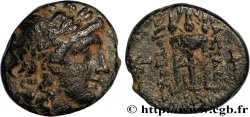Live auction - bgr_372394 - SYRIA - SELEUKID KINGDOM - ANTIOCHUS III THE GREAT Tétradrachme
You must signin and be an approved bidder to bid, LOGIN TO BID. Accounts are subject to approval and the approval process takes place within 48 hours. Do not wait until the day a sale closes to register. Clicking on "BID" constitutes acceptance of the terms of use of cgb.fr private live auctions.
Bids must be placed in whole Euro amounts only. The sale will start closing at the time stated on the item description; any bids received at the site after the closing time will not be executed. Transmission times may vary and bids could be rejected if you wait until the last second. For further information check the Live auction FAQ
All winning bids are subject to a 18% buyer’s fee.
All winning bids are subject to a 18% buyer’s fee.
| Estimate : | 2 200 € |
| Price : | 2 900 € |
| Maximum bid : | 2 900 € |
| End of the sale : | 15 December 2015 14:19:49 |
| bidders : | 4 bidders |
Type : Tétradrachme
Date: c. 212-210 AC.
Mint name / Town : Laodicée du Lycos
Metal : silver
Diameter : 28 mm
Orientation dies : 12 h.
Weight : 16,83 g.
Rarity : R1
Coments on the condition:
Exemplaire de qualité exceptionnelle sur un flan ovale, parfaitement centré des deux côtés. Portrait fantastique. Revers de haut relief. Jolie patine avec des reflets dorés. Conserve l’intégralité de son brillant de frappe et de son coupant d’origine
Catalogue references :
Predigree :
Cet exemplaire provient du stock d’Eukratides en 2003 et de la collection François Charrin
Obverse
Obverse legend : ANÉPIGRAPHE.
Obverse description : Tête diadémée d'Antiochus III à droite.
Reverse
Reverse description : Apollon nu assis à gauche sur l'omphalos, tenant une flèche de la main droite et appuyé sur son arc de la main gauche.
Reverse legend : [BA]SILEOS// ANT-IOCOU
Reverse translation : (du roi Antiochus).
Commentary
Exemplaire sans différent. Même coin de droit que l’exemplaire décrit dans l’ouvrage Seleucid Coins (SC. 998/3, pl. 49). “Qualité exceptionnelle du style baroque hellénistique et de la conservation du métal donnant des surfaces satinées avec de très légères traces ponctuelles d’oxydation et une légère patine dorée”. Ce type était précédemment attribué à l’atelier de Sardes, voir d’Antioche. L’attribution à Laodicée du Lycos semble attestée.








 Report a mistake
Report a mistake Print the page
Print the page Share my selection
Share my selection Ask a question
Ask a question Consign / sell
Consign / sell
 Full data
Full data















